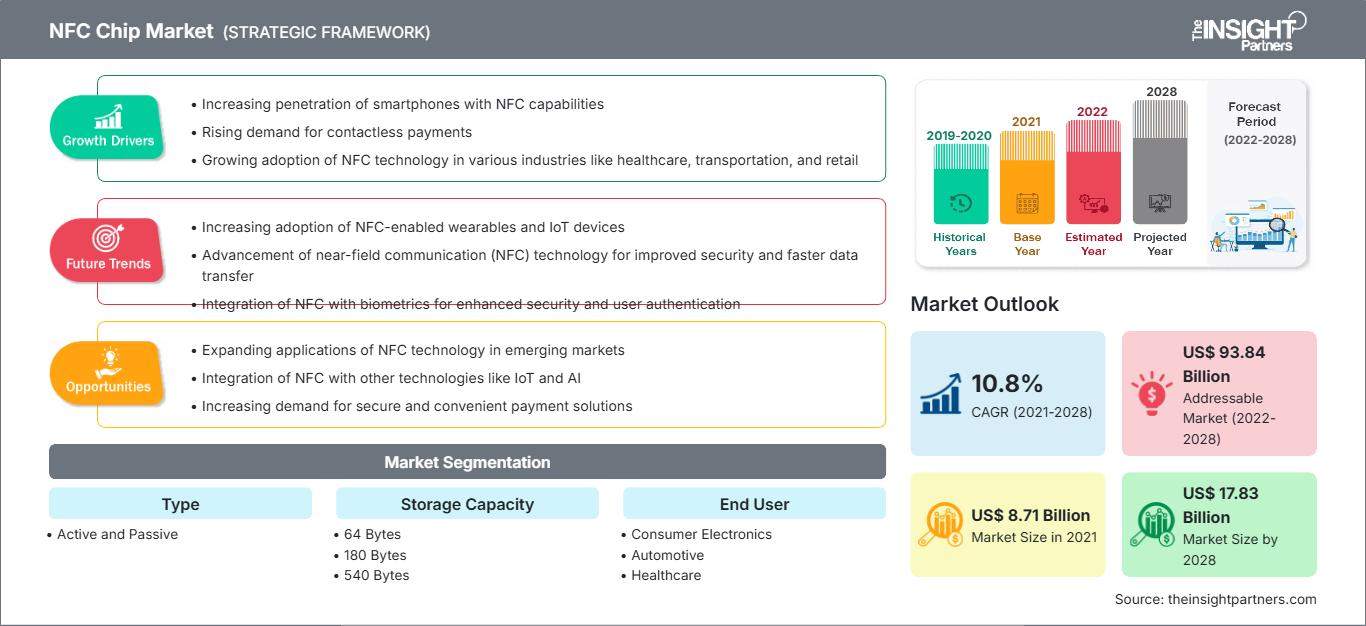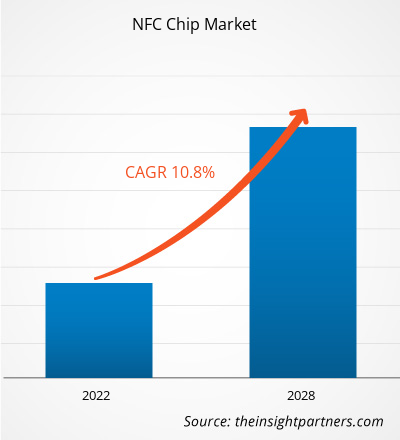Si prevede che il mercato dei chip NFC crescerà da 8.714,4 milioni di dollari nel 2021 a 17.827,0 milioni di dollari entro il 2028; si stima una crescita a un CAGR del 10,8% nel periodo 2021-2028.
Gli smartphone sono diventati parte integrante della vita dei consumatori di oggi. I consumatori utilizzano i loro telefoni cellulari per effettuare pagamenti più rapidi e veloci, oltre ai tradizionali metodi di comunicazione. La tecnologia NFC è un mezzo di pagamento pratico in quanto collega il dispositivo mobile del consumatore al suo portafoglio. Consente agli utenti di effettuare transazioni mobili, scambiare rapidamente contenuti digitali e collegare i propri dispositivi ad altri dispositivi tramite tocco. Di conseguenza, il numero di dispositivi dotati di tecnologia NFC è in crescita, contribuendo all'espansione e alla diffusione della tecnologia NFC nei mercati emergenti. I chip NFC semplificano l'utilizzo delle interfacce utente, rendendole più utili nei prodotti di consumo. I produttori di smartphone, come Apple e Samsung, includono chip NFC nei loro dispositivi, con conseguente aumento della domanda di chip NFC tra i produttori di telefoni cellulari. Con l'aumento dell'uso degli smartphone, aumenterà anche la penetrazione della tecnologia NFC, che a sua volta stimolerà la crescita del mercato dei chip NFC. Inoltre, la crescente adozione della digitalizzazione e delle tecnologie di comunicazione avanzate sta stimolando la domanda di chip NFC. Android Beam, ad esempio, è una funzione presente in tutti gli smartphone Android abilitati NFC. Gli utenti possono scambiare contenuti multimediali e contatti con un altro smartphone Android semplicemente avvicinando i loro telefoni. Poiché la tecnologia NFC consuma meno energia e può occasionalmente funzionare senza elettricità, rappresenta un modo comodo per condividere file digitali. I fattori sopra menzionati stanno avendo un impatto positivo sulla crescita del mercato dei chip NFC. La tecnologia NFC funziona anche in modalità peer-to-peer, oltre che per i pagamenti mobili e la distribuzione intelligente delle informazioni. Consente a due smartphone di scambiare contatti, attività del calendario, link a siti web, immagini e persino videoclip, in modo simile a Bluetooth e Wi-Fi Direct. L'NFC è una soluzione promettente per lo scambio e il commercio, e le piccole attività commerciali al dettaglio aumentano i propri profitti offrendo ai propri clienti transazioni fluide e semplici. I vantaggi sopra esposti relativi alla tecnologia NFC stanno generando opportunità di business redditizie per la crescita del mercato dei chip NFC.
Personalizza questo rapporto in base alle tue esigenze
Potrai personalizzare gratuitamente qualsiasi rapporto, comprese parti di questo rapporto, o analisi a livello di paese, pacchetto dati Excel, oltre a usufruire di grandi offerte e sconti per start-up e università
Mercato dei chip NFC: Approfondimenti strategici

- Ottieni le principali tendenze chiave del mercato di questo rapporto.Questo campione GRATUITO includerà l'analisi dei dati, che vanno dalle tendenze di mercato alle stime e alle previsioni.
Potrai personalizzare gratuitamente qualsiasi rapporto, comprese parti di questo rapporto, o analisi a livello di paese, pacchetto dati Excel, oltre a usufruire di grandi offerte e sconti per start-up e università
Mercato dei chip NFC: Approfondimenti strategici

- Ottieni le principali tendenze chiave del mercato di questo rapporto.Questo campione GRATUITO includerà l'analisi dei dati, che vanno dalle tendenze di mercato alle stime e alle previsioni.
Impatto della pandemia di COVID-19 sul mercato dei chip NFC
Il Nord America ha il più alto tasso di adozione e crescita delle nuove tecnologie grazie alle politiche governative favorevoli volte a promuovere l'innovazione e rafforzare le capacità infrastrutturali. Pertanto, si prevede che qualsiasi impatto sui settori influirà negativamente sulla crescita economica della regione. Gli Stati Uniti sono stati il paese più colpito al mondo dall'epidemia di COVID-19, influenzando così l'elevata adozione dello shopping online durante la pandemia. Ad esempio, secondo gli studi, Amazon ha registrato un aumento delle vendite del 37% a causa della pandemia di COVID-19.
La chiusura di tutti i punti vendita al dettaglio da parte delle autorità governative, unita alle norme di distanziamento sociale, ha influenzato gli investimenti dei punti vendita al dettaglio in qualsiasi progresso tecnologico. Ad esempio, le vendite del segmento della spesa online negli Stati Uniti hanno registrato un aumento del 210,1% a causa della pandemia. Questo aumento delle vendite online di beni di consumo ha ridotto la dipendenza della popolazione della regione dai negozi fisici. La pandemia di COVID-19 ha avuto un impatto positivo sulla crescita della tecnologia NFC grazie ai pagamenti contactless e senza carta, che a sua volta ha trainato il mercato dei chip NFC.
Approfondimenti sul mercato dei chip NFC
Impegno nell'adozione di tecnologie indossabili abilitate NFC
La tecnologia indossabile è una nuova tendenza che integra l'elettronica nelle attività quotidiane e risponde ai cambiamenti negli stili di vita consentendo di indossare i dispositivi su qualsiasi parte del corpo. La tecnologia indossabile è guidata dalla connessione a Internet e offre opzioni di scambio dati tra una rete e un dispositivo. Grazie all'aumento della tendenza al fitness tra i consumatori, la tecnologia indossabile ha riscosso grande popolarità. Secondo Cisco Systems, si prevede che i dispositivi indossabili connessi passeranno da 593 milioni nel 2018 a 1.105 milioni nel 2022 grazie a funzionalità aggiuntive, come la scelta di un marchio che si adatti allo stile di vita quotidiano. Marchi affermati come Apple e Fossil mantengono i prezzi costanti, mantenendo le fasce di prezzo tipiche degli orologi, per preservare le vendite. Molti altri produttori di orologi di lusso, come TAG e Armani, sono entrati nel segmento grazie a WearOS di Google. Nonostante i notevoli limiti di spazio e di potenza, i dispositivi indossabili intelligenti e IoT stanno diventando sempre più popolari grazie all'aggiunta di funzionalità aggiuntive. Quando un gadget indossabile è dotato di funzionalità NFC, può essere utilizzato per pagare in un negozio, utilizzare i mezzi pubblici o accedere a un edificio per uffici. SECORA Connect, ad esempio, è una famiglia di soluzioni di Infineon che risponde alla crescente popolarità dei dispositivi indossabili intelligenti e IoT. Si tratta di una soluzione di sistema che può essere implementata nei dispositivi indossabili intelligenti per consentire pagamenti sicuri contactless, biglietteria per i trasporti e altre applicazioni che utilizzano la tecnologia Near Field Communication (NFC). Pertanto, i fattori sopra menzionati stanno guidando la crescita del mercato dei chip NFC. Si prevede che nel periodo di previsione continueranno ulteriori investimenti e piani di crescita in queste tecnologie, il che creerà opportunità per i chip NFC nel settore.
Approfondimenti di mercato basati sull'utente finale
In base all'utente finale, il mercato dei chip NFC è segmentato in elettronica di consumo, automotive, vendita al dettaglio, medicale e altri settori. Nel settore della vendita al dettaglio, la maggior parte dei terminali POS NFC è stata installata in tutto il mondo a causa della crescente domanda di pagamenti contactless. Carrefour, un rivenditore con sede in Francia, ha lanciato Carrefour Pay, un sistema di pagamento mobile, che consente agli utenti di pagare la spesa con i propri smartphone abilitati NFC presso il terminale POS. Il sistema è stato collegato alle carte di tutte le banche ed è stato accettato in 3000 punti vendita in Francia. Il lancio di questo sistema fa parte del piano di Carrefour per la progettazione di operazioni digitali, supportato da un investimento di 3,39 miliardi di dollari. Con l'avvicinarsi del pensionamento dei sistemi più vecchi, i fornitori di POS includono sempre più il supporto NFC come standard nei nuovi sistemi. Inoltre, i clienti che utilizzano smartphone stanno adottando i pagamenti contactless in numero sempre crescente, poiché sono rapidi e convenienti.
Approfondimenti di mercato basati sulla capacità di archiviazione
In base alla capacità di archiviazione, il mercato dei chip NFC è segmentato in 64 byte, 168 byte, 180 byte e 540 byte. I chip NFC con bassa capacità di archiviazione vengono utilizzati per la gestione dell'inventario, la gestione della supply chain, il tracciamento delle risorse e l'automazione nella biglietteria e nella lotta alla contraffazione. I chip NFC con elevata capacità di archiviazione, come 180 byte e 540 byte, hanno un'elevata resistenza in lettura/scrittura e possono conservare fino a 50 anni di dati. Supportano anche SUN (messaggio NFC univoco sicuro), che abilita e semplifica molte applicazioni che coinvolgono sicurezza e crittografia, come anticontraffazione avanzata, applicazioni di dati sensibili protetti, accesso sicuro e autenticazione.
Mercato dei chip NFC
Le tendenze regionali e i fattori che influenzano il mercato dei chip NFC durante il periodo di previsione sono stati ampiamente spiegati dagli analisti di The Insight Partners. Questa sezione analizza anche i segmenti e la geografia del mercato dei chip NFC in Nord America, Europa, Asia-Pacifico, Medio Oriente e Africa, America Meridionale e Centrale.
Ambito del rapporto sul mercato dei chip NFC
| Attributo del rapporto | Dettagli |
|---|---|
| Dimensioni del mercato in 2021 | US$ 8.71 Billion |
| Dimensioni del mercato per 2028 | US$ 17.83 Billion |
| CAGR globale (2021 - 2028) | 10.8% |
| Dati storici | 2019-2020 |
| Periodo di previsione | 2022-2028 |
| Segmenti coperti |
By Tipo
|
| Regioni e paesi coperti | Nord America
|
| Leader di mercato e profili aziendali chiave |
|
Densità degli operatori del mercato dei chip NFC: comprendere il suo impatto sulle dinamiche aziendali
Il mercato dei chip NFC è in rapida crescita, trainato dalla crescente domanda degli utenti finali, dovuta a fattori quali l'evoluzione delle preferenze dei consumatori, i progressi tecnologici e una maggiore consapevolezza dei vantaggi del prodotto. Con l'aumento della domanda, le aziende stanno ampliando la propria offerta, innovando per soddisfare le esigenze dei consumatori e sfruttando le tendenze emergenti, alimentando ulteriormente la crescita del mercato.

- Ottieni il Mercato dei chip NFC Panoramica dei principali attori chiave
Gli operatori che operano nel mercato dei chip NFC adottano strategie come fusioni, acquisizioni e iniziative di mercato per mantenere le proprie posizioni sul mercato. Di seguito sono elencati alcuni sviluppi dei principali operatori:
- Nel 2021, Broadcom ha lanciato il chip ricevitore GNSS L1/L5 a più basso consumo energetico al mondo, il BCM4778, per applicazioni mobili e indossabili.
Il mercato globale dei chip NFC è segmentato in base a tipologia, capacità di archiviazione, utente finale e area geografica. In base alla tipologia, il mercato dei chip NFC è segmentato in attivo e passivo. In base alla capacità di archiviazione, il mercato è segmentato in 64 byte, 168 byte, 180 byte e 540 byte. In base all'utente finale, il mercato è segmentato in elettronica di consumo, automotive, vendita al dettaglio, assistenza sanitaria e altri.
AMS AG; Broadcom Inc.; Identiv, Inc; Toshiba Corporation; Intel Corporation; NXP Semiconductors; Samsung Electronics Co., Ltd.; Qualcomm Technologies, Inc.; STMicroelectronics; e Texas Instruments Incorporated sono i principali attori del mercato dei chip NFC presi in considerazione per lo studio di ricerca. Inoltre, in questo rapporto di ricerca sono stati studiati e analizzati diversi altri importanti attori del mercato dei chip NFC per ottenere una visione olistica del mercato globale dei chip NFC e del suo ecosistema.
- Analisi storica (2 anni), anno base, previsione (7 anni) con CAGR
- Analisi PEST e SWOT
- Valore/volume delle dimensioni del mercato - Globale, Regionale, Nazionale
- Industria e panorama competitivo
- Set di dati Excel
Report recenti
Testimonianze
Motivo dell'acquisto
- Processo decisionale informato
- Comprensione delle dinamiche di mercato
- Analisi competitiva
- Analisi dei clienti
- Previsioni di mercato
- Mitigazione del rischio
- Pianificazione strategica
- Giustificazione degli investimenti
- Identificazione dei mercati emergenti
- Miglioramento delle strategie di marketing
- Aumento dell'efficienza operativa
- Allineamento alle tendenze normative




















 Ottieni un campione gratuito per - Mercato dei chip NFC
Ottieni un campione gratuito per - Mercato dei chip NFC